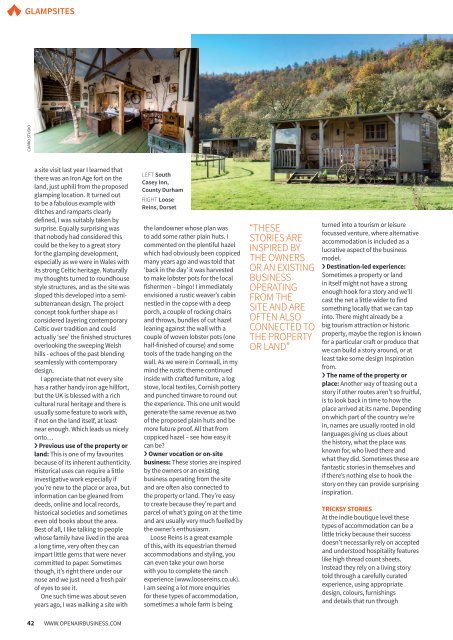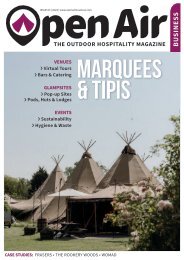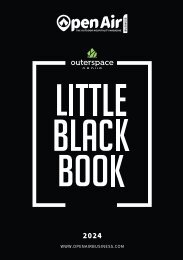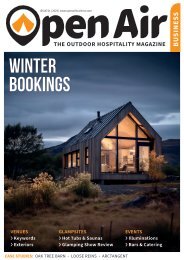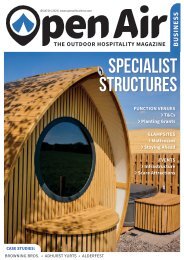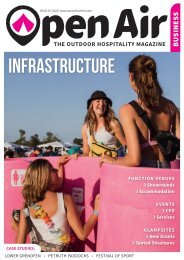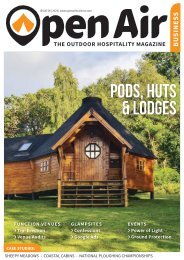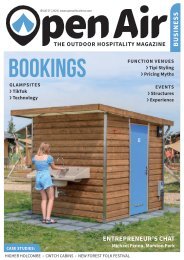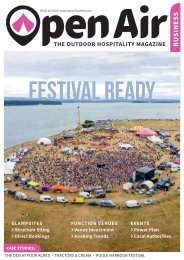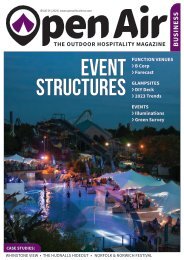February 2020
The UK's outdoor hospitality business magazine for function venues, glamping, festivals and outdoor events
The UK's outdoor hospitality business magazine for function venues, glamping, festivals and outdoor events
- No tags were found...
You also want an ePaper? Increase the reach of your titles
YUMPU automatically turns print PDFs into web optimized ePapers that Google loves.
GLAMPSITES<br />
CARRO STUDIO<br />
a site visit last year I learned that<br />
there was an Iron Age fort on the<br />
land, just uphill from the proposed<br />
glamping location. It turned out<br />
to be a fabulous example with<br />
ditches and ramparts clearly<br />
defined, I was suitably taken by<br />
surprise. Equally surprising was<br />
that nobody had considered this<br />
could be the key to a great story<br />
for the glamping development,<br />
especially as we were in Wales with<br />
its strong Celtic heritage. Naturally<br />
my thoughts turned to roundhouse<br />
style structures, and as the site was<br />
sloped this developed into a semisubterranean<br />
design. The project<br />
concept took further shape as I<br />
considered layering contemporary<br />
Celtic over tradition and could<br />
actually ‘see’ the finished structures<br />
overlooking the sweeping Welsh<br />
hills - echoes of the past blending<br />
seamlessly with contemporary<br />
design.<br />
I appreciate that not every site<br />
has a rather handy iron age hillfort,<br />
but the UK is blessed with a rich<br />
cultural rural heritage and there is<br />
usually some feature to work with,<br />
if not on the land itself, at least<br />
near enough. Which leads us nicely<br />
onto…<br />
› Previous use of the property or<br />
land: This is one of my favourites<br />
because of its inherent authenticity.<br />
Historical uses can require a little<br />
investigative work especially if<br />
you’re new to the place or area, but<br />
information can be gleaned from<br />
deeds, online and local records,<br />
historical societies and sometimes<br />
even old books about the area.<br />
Best of all, I like talking to people<br />
whose family have lived in the area<br />
a long time, very often they can<br />
impart little gems that were never<br />
committed to paper. Sometimes<br />
though, it’s right there under our<br />
nose and we just need a fresh pair<br />
of eyes to see it.<br />
One such time was about seven<br />
years ago, I was walking a site with<br />
LEFT South<br />
Casey Inn,<br />
County Durham<br />
RIGHT Loose<br />
Reins, Dorset<br />
the landowner whose plan was<br />
to add some rather plain huts. I<br />
commented on the plentiful hazel<br />
which had obviously been coppiced<br />
many years ago and was told that<br />
‘back in the day’ it was harvested<br />
to make lobster pots for the local<br />
fishermen – bingo! I immediately<br />
envisioned a rustic weaver’s cabin<br />
nestled in the copse with a deep<br />
porch, a couple of rocking chairs<br />
and throws, bundles of cut hazel<br />
leaning against the wall with a<br />
couple of woven lobster pots (one<br />
half-finished of course) and some<br />
tools of the trade hanging on the<br />
wall. As we were in Cornwall, in my<br />
mind the rustic theme continued<br />
inside with crafted furniture, a log<br />
stove, local textiles, Cornish pottery<br />
and punched tinware to round out<br />
the experience. This one unit would<br />
generate the same revenue as two<br />
of the proposed plain huts and be<br />
more future proof. All that from<br />
coppiced hazel – see how easy it<br />
can be?<br />
› Owner vocation or on-site<br />
business: These stories are inspired<br />
by the owners or an existing<br />
business operating from the site<br />
and are often also connected to<br />
the property or land. They’re easy<br />
to create because they’re part and<br />
parcel of what’s going on at the time<br />
and are usually very much fuelled by<br />
the owner’s enthusiasm.<br />
Loose Reins is a great example<br />
of this, with its equestrian themed<br />
accommodations and styling, you<br />
can even take your own horse<br />
with you to complete the ranch<br />
experience (www.loosereins.co.uk).<br />
I am seeing a lot more enquiries<br />
for these types of accommodation,<br />
sometimes a whole farm is being<br />
“THESE<br />
STORIES ARE<br />
INSPIRED BY<br />
THE OWNERS<br />
OR AN EXISTING<br />
BUSINESS<br />
OPERATING<br />
FROM THE<br />
SITE AND ARE<br />
OFTEN ALSO<br />
CONNECTED TO<br />
THE PROPERTY<br />
OR LAND”<br />
turned into a tourism or leisure<br />
focussed venture, where alternative<br />
accommodation is included as a<br />
lucrative aspect of the business<br />
model.<br />
› Destination-led experience:<br />
Sometimes a property or land<br />
in itself might not have a strong<br />
enough hook for a story and we’ll<br />
cast the net a little wider to find<br />
something locally that we can tap<br />
into. There might already be a<br />
big tourism attraction or historic<br />
property, maybe the region is known<br />
for a particular craft or produce that<br />
we can build a story around, or at<br />
least take some design inspiration<br />
from.<br />
› The name of the property or<br />
place: Another way of teasing out a<br />
story if other routes aren’t so fruitful,<br />
is to look back in time to how the<br />
place arrived at its name. Depending<br />
on which part of the country we’re<br />
in, names are usually rooted in old<br />
languages giving us clues about<br />
the history, what the place was<br />
known for, who lived there and<br />
what they did. Sometimes these are<br />
fantastic stories in themselves and<br />
if there’s nothing else to hook the<br />
story on they can provide surprising<br />
inspiration.<br />
TRICKSY STORIES<br />
At the indie boutique level these<br />
types of accommodation can be a<br />
little tricky because their success<br />
doesn’t necessarily rely on accepted<br />
and understood hospitality features<br />
like high thread count sheets.<br />
Instead they rely on a living story<br />
told through a carefully curated<br />
experience, using appropriate<br />
design, colours, furnishings<br />
and details that run through<br />
42 WWW.OPENAIRBUSINESS.COM


